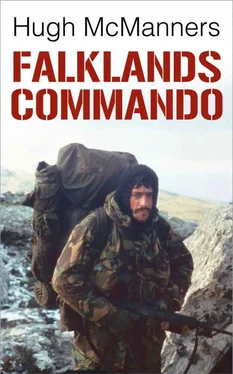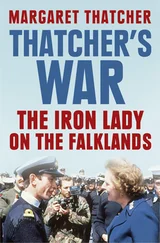Hugh McManners - Falklands Commando
Здесь есть возможность читать онлайн «Hugh McManners - Falklands Commando» весь текст электронной книги совершенно бесплатно (целиком полную версию без сокращений). В некоторых случаях можно слушать аудио, скачать через торрент в формате fb2 и присутствует краткое содержание. Город: London, Год выпуска: 2014, ISBN: 2014, Издательство: Nightstrike Publishing, Жанр: nonf_military, Биографии и Мемуары, на английском языке. Описание произведения, (предисловие) а так же отзывы посетителей доступны на портале библиотеки ЛибКат.
- Название:Falklands Commando
- Автор:
- Издательство:Nightstrike Publishing
- Жанр:
- Год:2014
- Город:London
- ISBN:978-0-992-81540-0
- Рейтинг книги:4 / 5. Голосов: 1
-
Избранное:Добавить в избранное
- Отзывы:
-
Ваша оценка:
- 80
- 1
- 2
- 3
- 4
- 5
Falklands Commando: краткое содержание, описание и аннотация
Предлагаем к чтению аннотацию, описание, краткое содержание или предисловие (зависит от того, что написал сам автор книги «Falklands Commando»). Если вы не нашли необходимую информацию о книге — напишите в комментариях, мы постараемся отыскать её.
Falklands Commando — читать онлайн бесплатно полную книгу (весь текст) целиком
Ниже представлен текст книги, разбитый по страницам. Система сохранения места последней прочитанной страницы, позволяет с удобством читать онлайн бесплатно книгу «Falklands Commando», без необходимости каждый раз заново искать на чём Вы остановились. Поставьте закладку, и сможете в любой момент перейти на страницу, на которой закончили чтение.
Интервал:
Закладка:
Since its initial publication in 1984, many people have written to tell me that reading Falklands Commando made them want to join the Armed Forces. I’m still asked to sign ancient first editions belonging to now-senior officers who’ve said the same thing.
But because Falklands Commando ended with our return home, plus a few reflections from the Army Staff College at Camberley where I finalised the editing, it creates the impression of everyone living happily ever after. Unfortunately, as I hadn’t realised at the time, that is all too often not the case.
So although my account of the events of 1982 is accurate, honest and others tell me evocative, there is a further story to be told, which I hope to publish in due course. Mine is to varying degrees much the same as that of a significant percentage of members of the Falklands Task, and veterans of the Gulf War, Iraq and Afghanistan – not forgetting those sucked into the tragedy of Northern Ireland, Bosnia, Kosovo and other campaigns.
How many are affected by their military combat experiences is a moot point: the MoD says 2-4% of everybody who deploys, whereas other British and US research indicates 14% to 20% and more, depending on unit, combat intensity and other factors. These are very large numbers of people, who try to hide their symptoms and live normally – as I did. Special Forces are particularly affected, as they do the most business.
These are very dangerous times. We need fighting soldiers to keep our world functioning. Modern weapons and munitions are very much more powerful than ever before; today’s operations more complex, unpredictable and stressful, making the soldiers of today far more vulnerable to psychological problems than ever before.
They risk their lives for us . More needs to be done to help them .
St Clements, Oxford January 2014Chapter 1. The Calm Before the Storm
On 2 April 1982 I went down to Cornwall for Easter leave – a few days early, on the excuse of reconnoitring parachute-dropping zones for an exercise to be held in the summer. I travelled from my base at the Royal Marines Poole in Dorset in a blue RAF Ford Escort driven by Flight Lieutenant Jeff Diggle – of the Special Forces Flight. We were both very keen get out of the office.
We spent the day tramping the wet tussocks and sand dunes around Perranporth, chatting about approach headings for aircraft and hazards for paratroopers. There were disused mineshafts for the unwary to drop into, and critical tides to be built into the plan.
The day was extraordinarily bright, washed clean as it always is in Cornwall when the rain stops. We could see the church at Cubert – far larger than Cubert itself, and across green–capped dunes, the wind-worn granite of Perran Cross and its companion mound and large white cross. This mysterious hillock protects the remains of the tiny sixth century church of Saint Piran, reburied to save it from the elements. The now empty shanties of the ghastly Perranporth caravan site littered the dunes, under which is said to lie the storm-ruined city of Langarrow, a Cornish ‘Sodom’ which perished to be overlaid by the oldest Christian church in the country, and then this caravan site.
A flat-topped hill, with the small cruciform of houses that form the hamlet of Rose, was a misty pastel green, blurred by the vivid blue of the sea, the white of the choppy clouds and merged into the soft green of the land. Seagulls wheeled and squawked, and the chunter of a tractor carried a long way in the constant buffet of the wind.
The temperature was brisk, but with a mellowing of the sort that is not strictly to do with a few extra degrees on the thermometer. The long, wet haul of winter was ending, the winter world taking a few deep breaths in preparation for spring, and then the hectic activity of the summer. Quietly waking, the harsh, natural beauty of the North Cornwall coast was softening, to show its underlying gentleness.
Jeff Diggle and I ate pasties washed down with tea in a large formica-clad seaside café in Perranporth, bored waitresses staring blankly through misted-up plate glass windows. We sat, intruders amid deserted tables, out of place in our camouflage smocks and high-calved parachute boots. Apart from us, the café was empty for the summer onslaught, all systems ready to go – the calm before the storm.
I owned a stone house on the main street of St Agnes, once the residence of the Mine Captain – a man of local importance. Being an army captain was considered acceptable to ownership of this very solid building. My back garden was overlooked by the chimney of what had once been the beam engine house for one of the many mine shafts in the area.
Today, peace and tranquillity cloak St Agnes’ old port of Trevaunance Cove, which was once busy with the noise and dust of an ore crushing and sifting factory. St Agnes village is at the top of the hill, well above what would have been a dirty, smoky industrial landscape. Its houses are small, with thick granite walls and slate roofs, their woodwork painted white or green, with front doors of brighter, even vivid, colours. Milder seaside weather and the more southerly latitude enable the incongruity of occasional palm trees. A Cornish winter is grey and dull, with only the slate roofs shiny with water. But in clear sunshine the transformation is dramatic: glorious sunshine, washing lines billowing with bed sheets.
After two months of arctic mountain training in the cold, monochrome of Norway, my two-week’s leave would be bright and varied. Repairs were required to the old house, boozing with the Perranporth ‘Brewers’ rugby club on Saturday night, risking all in the surf, and running every day along the cliffs, alone with gulls and the ocean.
I spent my first evening amongst friends at the St Agnes Hotel, a few yards down the main street from my house. The front bar was dark and cosy, walls covered with model ships, photos of life-boat crews both old and new; and of the port in its heyday, with sailing ships being loaded with ore down chutes from horse drawn carts. I made arrangements to meet there the next evening.
However at six o’clock the next morning, Maurice the local policeman knocked on my door. I was to report back to Royal Marines Poole at once, no reason given. He waited with his panda car then drove me to Truro station for the next train up-country.
I was returning to Royal Marines Poole, a modern military camp at the edge of Poole harbour, next door to the Rockley Sands holiday camp. The full name of my military unit was ‘148 Commando Forward Observation Battery Royal Artillery’, based at Poole almost since the camp was created, in the grounds of a shooting lodge owned by Lord Wimborne.
Our unit cipher was the red-on-blue Combined Operations flash with interlinked Thompson sub-machine gun, and eagle upon an anchor, signifying the combination of expertise involved, first worn by the Second World War commandos. Back then, the Royal Navy provided coxswains for the assault boats, and the Army the soldiers to form the raiding parties that caused mayhem along the coast of occupied France.
148 Battery still recruits from both the Army and the Royal Navy. It is the only surviving commando unit that combines the expertise of the two services, as in those early days.
Joining 148 Battery entails an arduous selection process: a preparatory ‘beat up’ and then the Commando Course at the Commando Training Centre at Lympstone. As you travel on the train from Exeter to Plymouth, as I was that morning, you can see it on the far side of the River Exe estuary. Its modern buildings and grass banks belie the nature of its purpose, although you may see small figures with weapons and webbing equipment being made to run in the mud at low tide, or going endlessly around the assault course.
Читать дальшеИнтервал:
Закладка:
Похожие книги на «Falklands Commando»
Представляем Вашему вниманию похожие книги на «Falklands Commando» списком для выбора. Мы отобрали схожую по названию и смыслу литературу в надежде предоставить читателям больше вариантов отыскать новые, интересные, ещё непрочитанные произведения.
Обсуждение, отзывы о книге «Falklands Commando» и просто собственные мнения читателей. Оставьте ваши комментарии, напишите, что Вы думаете о произведении, его смысле или главных героях. Укажите что конкретно понравилось, а что нет, и почему Вы так считаете.












